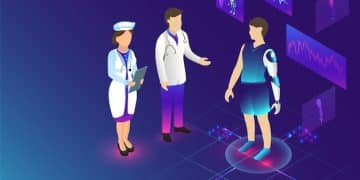Predictive Analytics in US Healthcare: Preventing Disease Outbreaks with AI

Predictive analytics in US healthcare uses artificial intelligence (AI) to analyze data, forecast potential health crises, and enable proactive interventions to prevent disease outbreaks.
The US healthcare system is constantly seeking innovative solutions to improve patient outcomes and reduce costs. One of the most promising approaches is the use of predictive analytics in US healthcare, which leverages artificial intelligence to forecast potential health crises and enable proactive interventions before disease outbreaks occur.
Understanding Predictive Analytics in Healthcare
Predictive analytics is revolutionizing various sectors, and healthcare is no exception. This technology uses historical data, statistical algorithms, and machine learning techniques to identify patterns and predict future outcomes. In healthcare, this translates to anticipating disease outbreaks, identifying high-risk patients, and optimizing resource allocation.
By analyzing vast datasets of patient information, including medical records, demographic data, and even social media activity, predictive analytics models can identify risk factors and predict the likelihood of certain events occurring. This allows healthcare providers to take proactive steps to prevent or mitigate these events, leading to better patient outcomes and reduced healthcare costs.
Key Components of Predictive Analytics
Several key components work together to enable effective predictive analytics in healthcare:
- Data Collection: Gathering comprehensive data from various sources, including electronic health records (EHRs), insurance claims, and public health databases.
- Data Analysis: Applying statistical algorithms and machine learning techniques to identify patterns and correlations within the data.
- Model Building: Developing predictive models based on the insights gained from data analysis.
- Model Validation: Testing the accuracy and reliability of the predictive models using historical data.
- Deployment and Monitoring: Implementing the predictive models in clinical settings and continuously monitoring their performance.
Predictive analytics offers a powerful tool for improving healthcare delivery in the US, enabling providers to make more informed decisions and take proactive measures to prevent disease outbreaks and improve patient care.
The Role of AI in Predictive Analytics for Disease Prevention
Artificial intelligence (AI) plays a crucial role in enhancing predictive analytics capabilities, particularly in the context of disease outbreak prevention. AI algorithms can process and analyze vast amounts of data much faster and more accurately than traditional statistical methods, enabling earlier detection and prediction of outbreaks.
AI’s ability to identify subtle patterns and anomalies within complex datasets enables healthcare professionals to gain insights that might otherwise be missed. This early warning system can be critical in mobilizing resources and implementing preventive measures to contain outbreaks before they escalate.
How AI Enhances Predictive Accuracy
AI algorithms improve predictive accuracy in several ways:
- Machine Learning: AI algorithms can learn from data and improve their predictive accuracy over time.
- Natural Language Processing (NLP): NLP enables AI to analyze unstructured data, such as doctor’s notes and social media posts, to identify potential health risks.
- Deep Learning: Deep learning algorithms can identify complex patterns in data that are difficult for humans to detect.
AI-powered predictive analytics systems are instrumental in transforming reactive healthcare models into proactive ones, saving lives and reducing the burden on the healthcare system.

Applications of Predictive Analytics in US Healthcare
Predictive analytics has a wide range of applications within the US healthcare system, spanning from identifying at-risk patients to predicting hospital readmissions and optimizing treatment plans. By leveraging predictive models, healthcare providers can enhance patient care and streamline operational efficiency.
One of the most promising applications is in preventing disease outbreaks. By analyzing data on disease incidence, environmental factors, and population demographics, predictive models can identify areas at high risk for outbreaks and enable targeted interventions.
Specific Use Cases in Disease Outbreak Prevention
Here are some specific examples of how predictive analytics is being used to prevent disease outbreaks:
- Influenza Prediction: Predicting the timing and severity of influenza outbreaks to enable timely vaccination campaigns.
- COVID-19 Monitoring: Tracking the spread of COVID-19 and identifying potential hotspots to implement targeted interventions.
- Waterborne Disease Detection: Monitoring water quality data to predict and prevent outbreaks of waterborne diseases.
These applications highlight the potential of predictive analytics to transform healthcare delivery and improve public health outcomes.
Benefits of Using Predictive Analytics in Healthcare
The implementation of predictive analytics in healthcare offers numerous benefits, leading to more efficient, cost-effective, and patient-centric care. By leveraging AI, healthcare providers can enhance their ability to predict and prevent diseases, reduce hospital readmissions, and improve overall patient outcomes.
One of the primary benefits is the ability to proactively identify and manage high-risk patients, ensuring they receive the necessary interventions before their conditions worsen. This proactive approach not only improves patient well-being but also reduces the strain on healthcare resources.
Key Advantages for Healthcare Providers
Here are some of the key advantages of using predictive analytics in healthcare:
- Improved Patient Outcomes: Early detection and intervention lead to better health outcomes for patients.
- Reduced Healthcare Costs: Proactive management of health risks can prevent costly hospitalizations and emergency room visits.
- Optimized Resource Allocation: Predictive models can help healthcare providers allocate resources more efficiently, ensuring that resources are directed to where they are needed most.
- Enhanced Operational Efficiency: Predictive analytics can streamline processes and improve the efficiency of healthcare operations.
These benefits underscore the transformative potential of predictive analytics in shaping the future of healthcare.

Challenges and Considerations for Implementation
While the potential benefits of predictive analytics in healthcare are significant, implementing these technologies is not without its challenges. Addressing these challenges is critical for ensuring successful adoption and maximizing the value of predictive analytics in improving healthcare outcomes.
One of the primary challenges is data quality and availability. Predictive models rely on accurate and complete data, and gaps or inaccuracies in the data can significantly impact the reliability of the predictions.
Addressing the Key Implementation Hurdles
Here are some key challenges and considerations for implementing predictive analytics in healthcare:
- Data Quality: Ensuring the accuracy, completeness, and consistency of the data used to train predictive models.
- Data Privacy and Security: Protecting patient data and complying with regulatory requirements, such as HIPAA.
- Model Interpretability: Understanding how predictive models arrive at their predictions to ensure transparency and accountability.
- Integration with Existing Systems: Integrating predictive analytics tools with existing EHRs and other healthcare systems.
- Workforce Training: Providing healthcare professionals with the training they need to effectively use and interpret predictive analytics insights.
Addressing these challenges proactively can pave the way for successful implementation and widespread adoption of predictive analytics in healthcare.
Future Trends in AI-Driven Predictive Analytics
The field of AI-driven predictive analytics is rapidly evolving, with new advancements and innovations continually emerging. As technology advances, the capabilities of predictive models in healthcare are expected to grow, offering even more effective solutions for disease prevention and patient care.
One of the key trends is the integration of real-time data sources, such as wearable devices and social media, to provide more timely and accurate predictions. This integration allows for continuous monitoring and early detection of potential health risks.
Emerging Technologies and Innovations
Here are some emerging technologies and innovations that are shaping the future of AI-driven predictive analytics in healthcare:
- Federated Learning: Training predictive models on decentralized data sources without sharing sensitive patient information.
- Explainable AI (XAI): Developing AI models that can explain their predictions in a clear and understandable manner.
- Personalized Medicine: Using predictive analytics to tailor treatments and interventions to individual patient needs.
These trends promise to further transform healthcare delivery, making it more proactive, personalized, and effective.
| Key Point | Brief Description |
|---|---|
| 💡 AI in Healthcare | AI enhances data analysis and prediction accuracy in healthcare. |
| 🎯 Predictive Models | Predictive models analyze data to forecast health crises and enable proactive interventions. |
| 🛡️ Data Challenges | Addressing data quality, privacy, and security is crucial for effective implementation. |
| 🚀 Future Trends | Emerging trends include federated learning and explainable AI for personalized medicine. |
Frequently Asked Questions
Predictive analytics in healthcare uses data analysis and AI to forecast potential health issues, allowing proactive interventions and better patient outcomes.
AI algorithms process vast amounts of data quickly and accurately, identifying patterns and anomalies that enhance predictive capabilities for disease prevention.
Benefits include improved patient outcomes, reduced costs, optimized resource allocation, and enhanced operational efficiency for healthcare providers in the US.
Main challenges include ensuring data quality, protecting patient privacy, and integrating new tools with existing healthcare systems for effective use.
Future trends involve integrating real-time data, using federated learning, and developing explainable AI for personalized and effective healthcare solutions.
Conclusion
In conclusion, predictive analytics in US healthcare, driven by AI, represents a paradigm shift towards proactive and personalized healthcare. By addressing data challenges and embracing emerging technologies, the healthcare industry can harness the full potential of AI to prevent disease outbreaks and improve patient outcomes across the nation.





